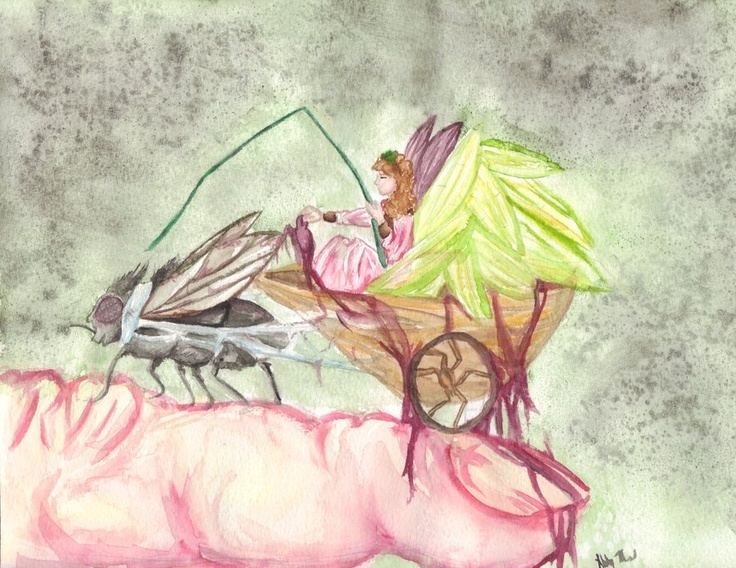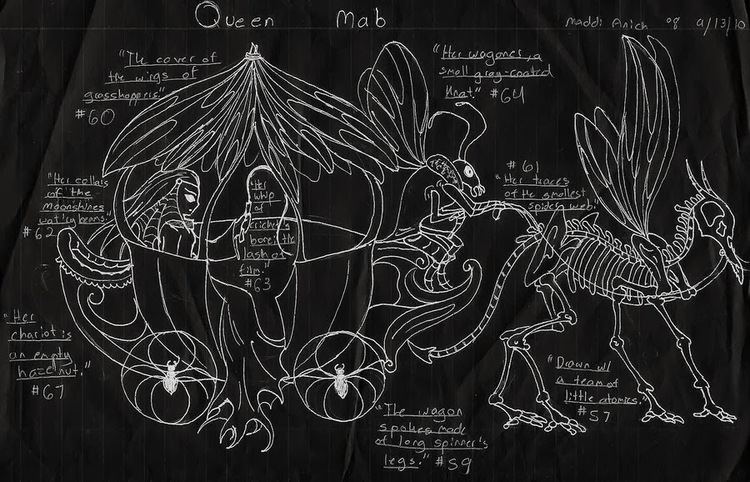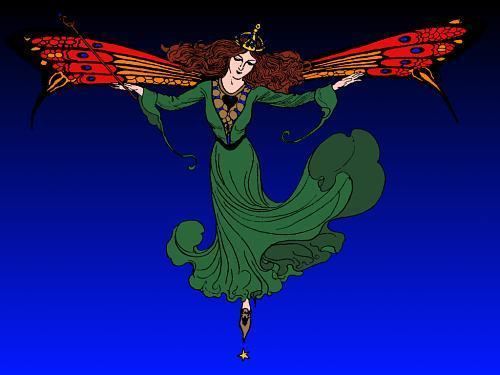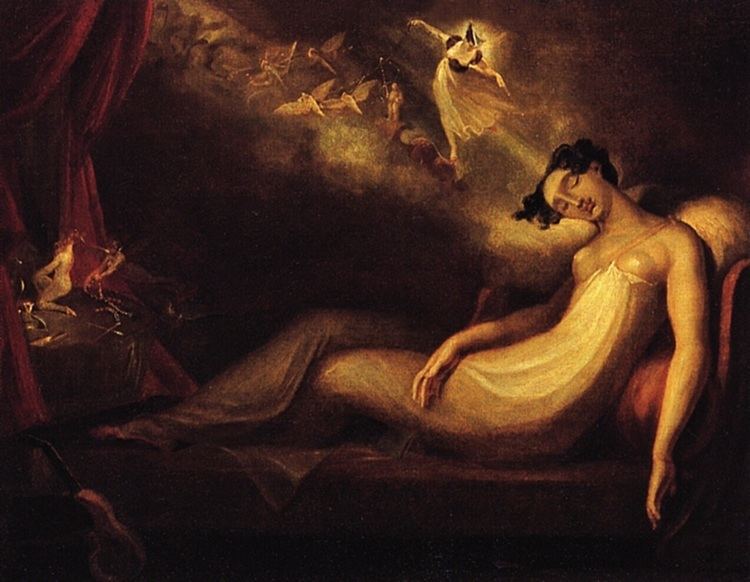 | ||
Similar | ||
Becca stevens queen mab audio
Queen Mab (pronunciation: "M/ă/v") is a fairy referred to in William Shakespeare's play Romeo and Juliet, where "she is the fairies' midwife." Later, she appears in other poetry and literature, and in various guises in drama and cinema. In the play, her activity is described in a famous speech by Mercutio written originally in prose and often adapted into iambic pentameter, in which she is described as a miniature creature who performs midnight pranks upon sleepers. Being driven by a team of atomies, she rides her chariot over their noses and "delivers the fancies of sleeping men." Additionally, while driving "O'er ladies' lips, who straight on kisses dream," she was known to change her mind and instead "plague" "ladies' lips" "with blisters" if she smelled "sweetmeats" or candied fruit eaten to sweeten their breath. Along with this interpretation, others believe the blisters were a reference to the plague or to herpes simplex. She is also described as a midwife to help sleepers 'give birth' to their dreams. She may be a figure borrowed from folklore, and though she is often associated with the Irish Medb in popular culture, and has been suggested by historian Thomas Keightley to be from Habundia, a more likely origin for her name would be from Mabel and the Middle English derivative "Mabily" (as used by Chaucer) all from the Latin amabilis ("lovable").
Contents
- Becca stevens queen mab audio
- Becca stevens queen mab official music video
- Mercutios speech in the adapted prose version
- In other literature
- Film and television
- References

Becca stevens queen mab official music video
Mercutio's speech (in the adapted prose version)

"O, then, I see Queen Mab hath been with you.
She is the fairies’ midwife, and she comes
In shape no bigger than an agate-stone
On the fore-finger of an alderman,
Drawn with a team of little atomies
Athwart men's noses as they lies asleep;
Her wagon-spokes made of long spinners’ legs,
The cover of the wings of grasshoppers,
The traces of the smallest spider's web,
The collars of the moonshine's wat'ry beams,
Her whip of cricket's bone; the lash of film;
Her waggoner a small grey-coated gnat,
Not half so big as a round little worm
Pricked from the lazy finger of a maid:
Her chariot is an empty hazelnut
Made by the joiner squirrel or old grub,
Time out o’ mind the fairies’ coachmakers.
And in this state she gallops night by night
Through lovers’ brains, and then they dream of love;
O’er courtiers’ knees, that dream on court'sies straight,
O’er lawyers’ fingers, who straight dream on fees,
O’er ladies' lips, who straight on kisses dream,
Which oft the angry Mab with blisters plagues,
Because their breaths with sweetmeats tainted are:
Sometime she gallops o’er a courtier's nose,
And then dreams he of smelling out a suit;
And sometime comes she with a tithe-pig's tail
Tickling a parson's nose as a’ lies asleep,
Then dreams, he of another benefice:
Sometime she driveth o’er a soldier's neck,
And then dreams he of cutting foreign throats,
Of breaches, ambuscadoes, Spanish blades,
Of healths five-fathom deep; and then anon
Drums in his ear, at which he starts and wakes,
And being thus frighted swears a prayer or two
And sleeps again. This is that very Mab
That plaits the manes of horses in the night,
And bakes the elflocks in foul sluttish hairs,
Which once untangled, much misfortune bodes:
This is the hag, when maids lie on their backs,
That presses them and learns them first to bear,
Making them women of good carriage:
This is she—"
— Mercutio in Romeo and Juliet, Act I, scene IV
In other literature

After her literary debut (as far as we can tell by examining the surviving literature) in Romeo and Juliet, she appears in works of seventeenth-century poetry, notably Ben Jonson's "The Entertainment at Althorp" and Michael Drayton's "Nymphidia". In Poole's work Parnassus, Mab is described as the Queen of the Fairies and consort to Oberon, Emperor of the Fairies.
"Queen Mab" is a 1750 pantomime by Henry Woodward (English actor).

Queen Mab: A Philosophical Poem (1813) is the title of the first large poetic work written by the famous English Romantic poet, Percy Bysshe Shelley (1792–1822).
Herman Melville's epic American novel Moby Dick (1851) includes a chapter called "Queen Mab". The 31st chapter of Melville's work is entitled such because it describes a dream by Captain Ahab's second mate, Stubb.
In J. M. Barrie's The Little White Bird (1902) Queen Mab lives in Kensington Gardens and grants Peter Pan – who has learned he is a boy, and thus can no longer fly – his wish to fly again.
American philosopher George Santayana wrote a short piece entitled "Queen Mab" which appeared in his 1922 book Soliloquies in England and Later Soliloquies. This particular soliloquy considers English literature as an indirect form of self-expression in which the English writer "will dream of what Queen Mab makes other people dream" rather than revealing him or herself.
In several of Jim Butcher's The Dresden Files books, Queen Mab is an important recurring supporting character, with mysterious motives.
In Grant Morrison's comic book series "The Invisibles", Beryl Wyndhams code name is "Queen Mab".
Queen Mab is the queen of the Unseelie Court in Julie Kagawa's The Iron Fey series.
Queen Mab is one of the three ancient Fae queens, sister to Maeve and Mora, in Sarah J. Maas's Throne of Glass series.
"Queen Mab" is the name of the city in which the majority of Dan Abnett's novel Pariah takes place.
Film and television
In the first episode of season four of HBO's original series True Blood, Queen Mab (portrayed by Rebecca Wisocky) is the Queen of Faerie who centuries ago ordered the fae to retreat to the Plane of Faerie in the wake of vampire aggression. Under her orders, humans with fae blood (including Sookie Stackhouse) are being drawn into Faerie as well. When Sookie rebels against her and escapes back to the mortal realm, Queen Mab seals the Faerie portals for good, trapping the half-fae with her and a handful of true fae in Bon Temps.
Although not connected with him in the original source material, Queen Mab has been featured in media series featuring Merlin. She is portrayed by Miranda Richardson in the 1998 TV miniseries Merlin, serving as prominent antagonist to the title character; she is the dark twin to the Lady of the Lake. In an episode of Hercules: The Legendary Journeys from the same year, she is an evil enchantress who has corrupted Arthur; Merlin sends the pair back in time to learn a lesson in humility from Hercules. The 2008 TV series Merlin features Queen Mab as a character in an episode of the show's fifth season, which portrays her as a diminutive green fairy.
